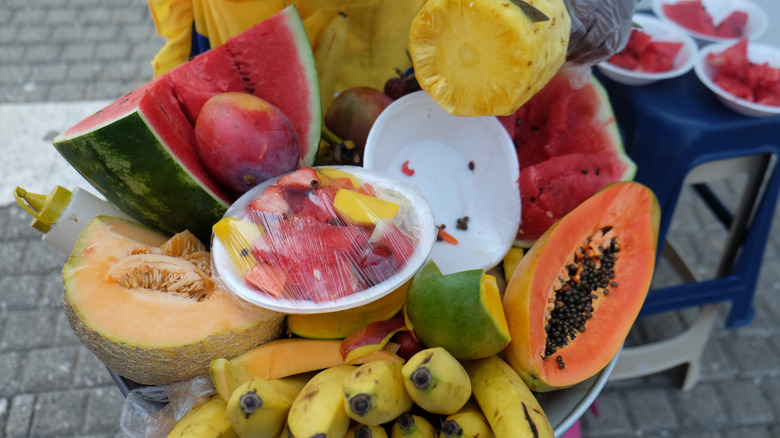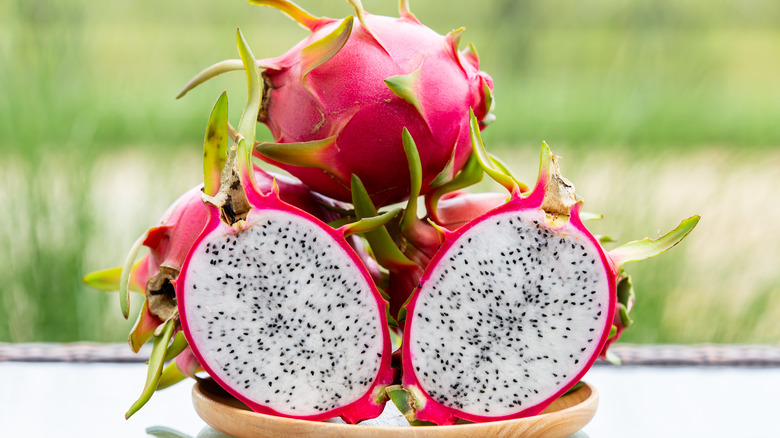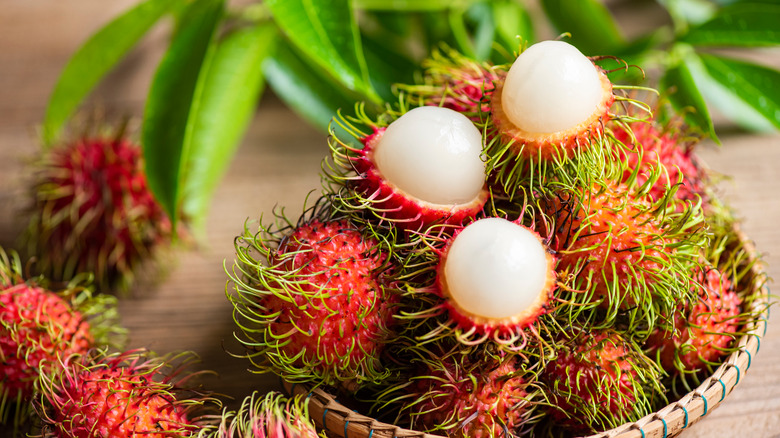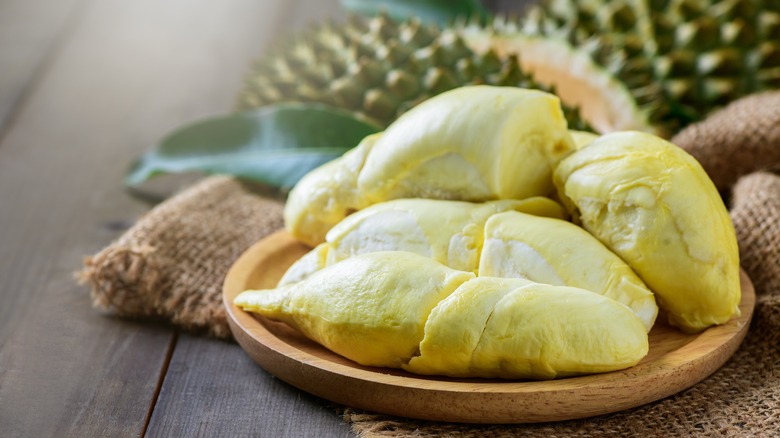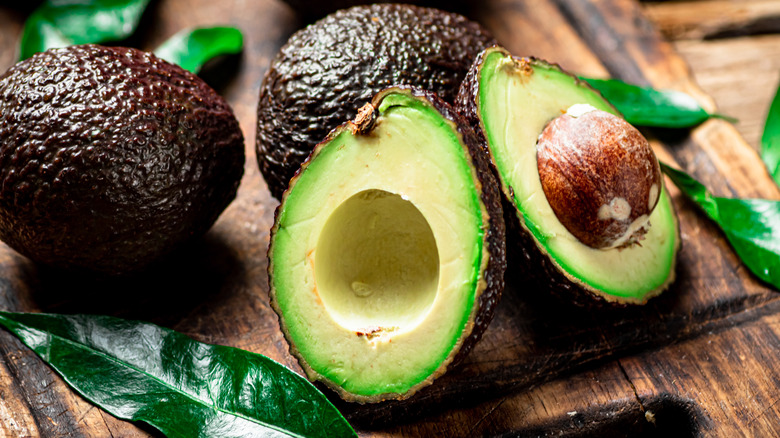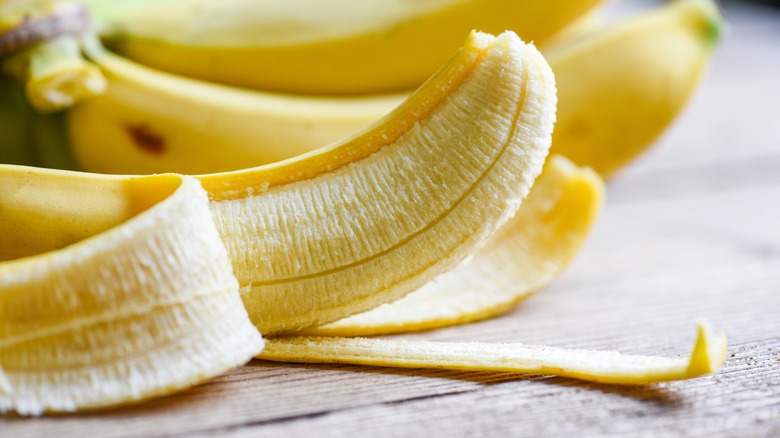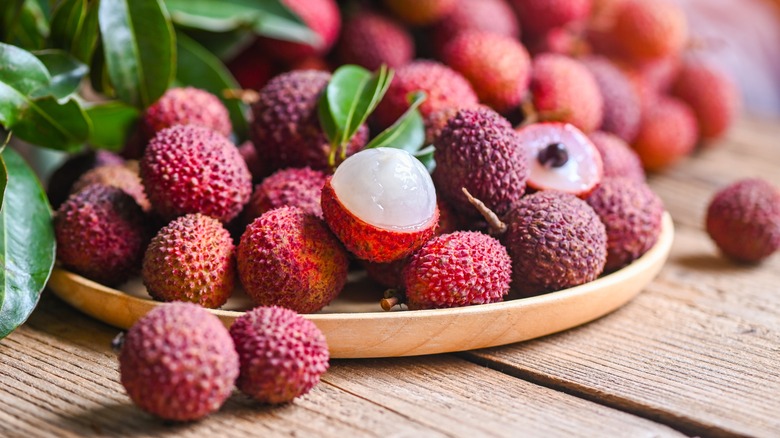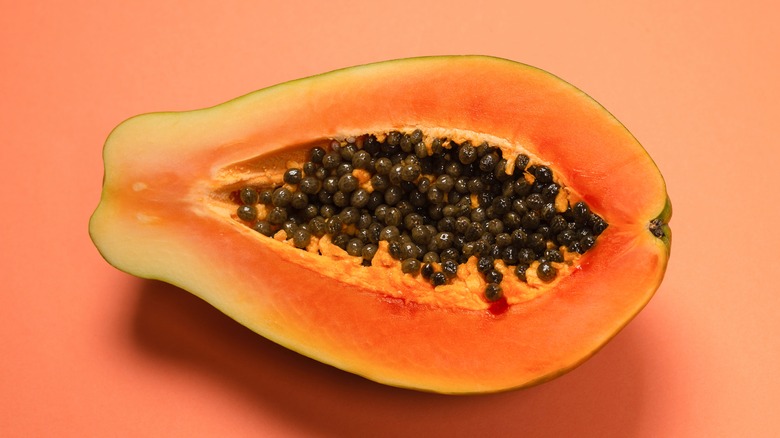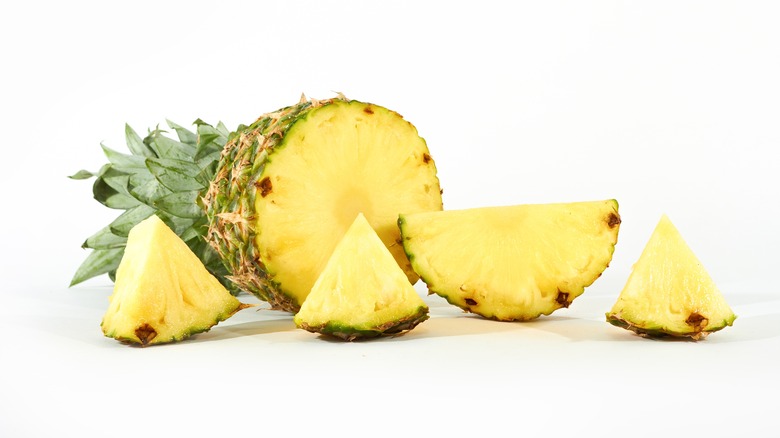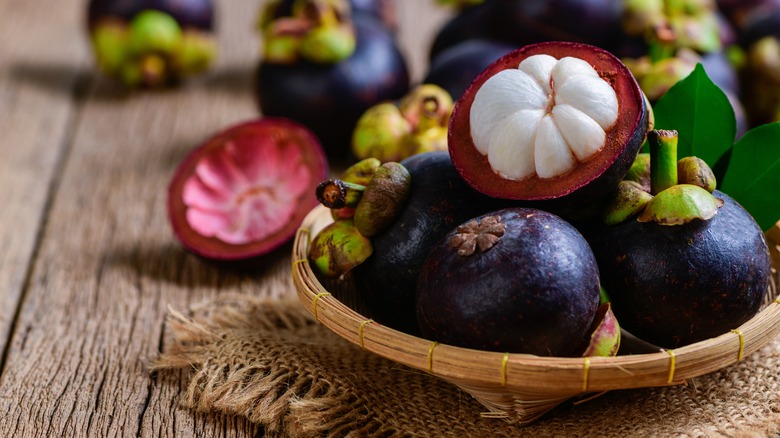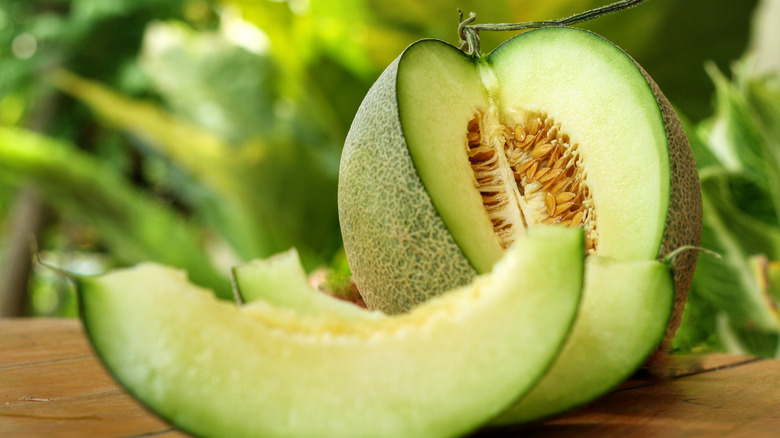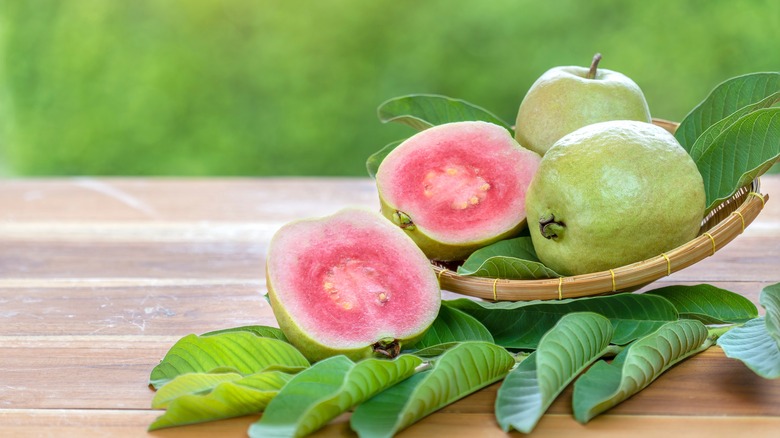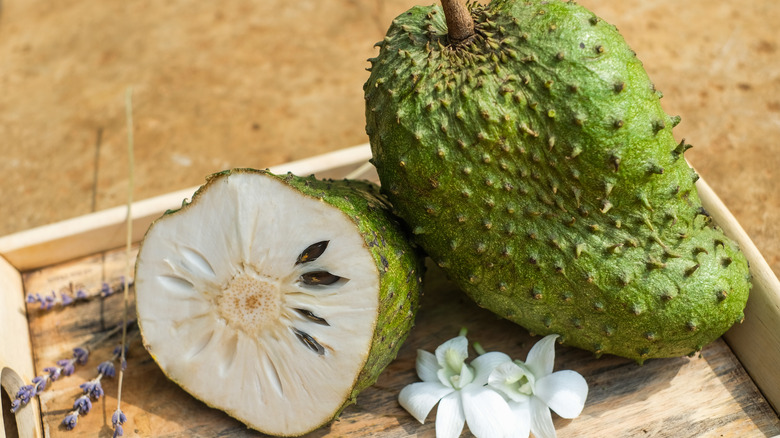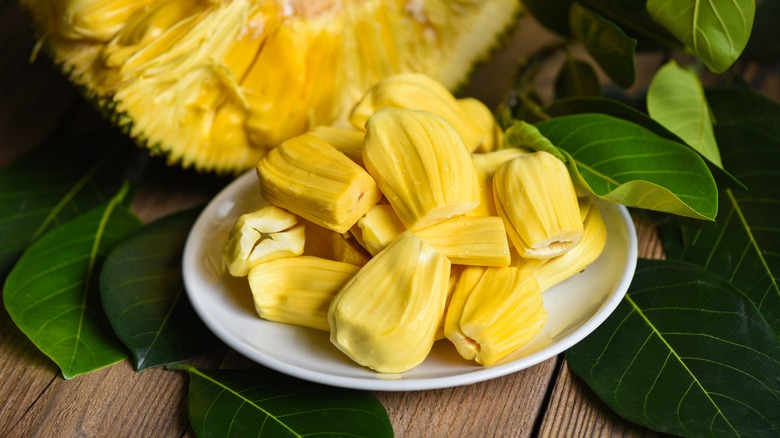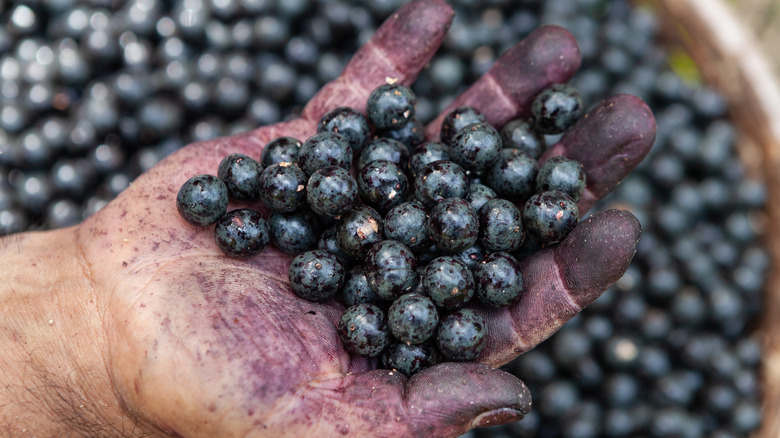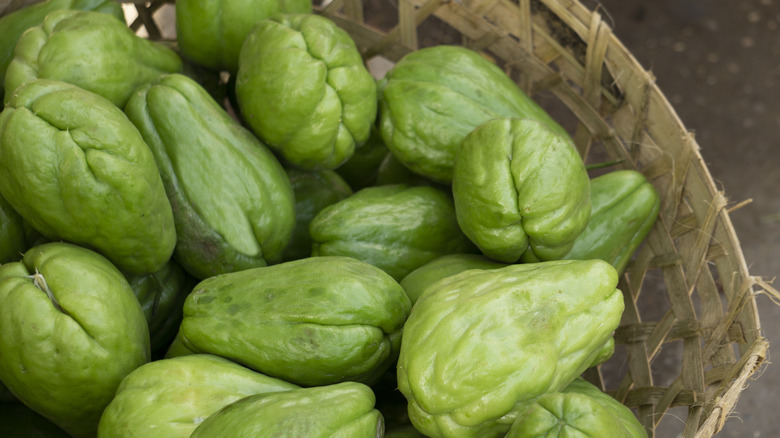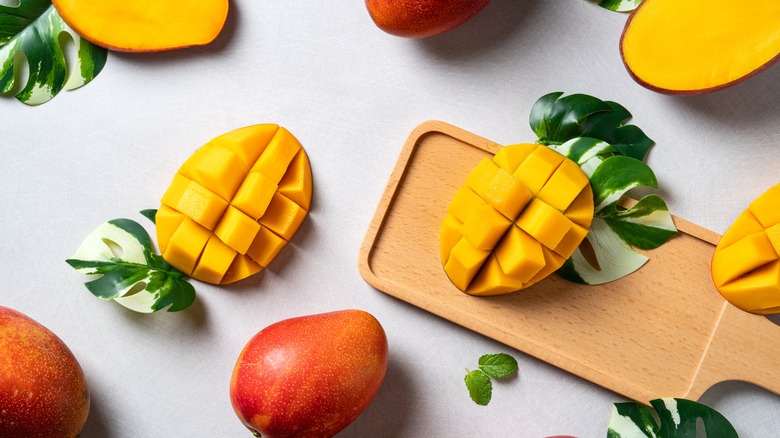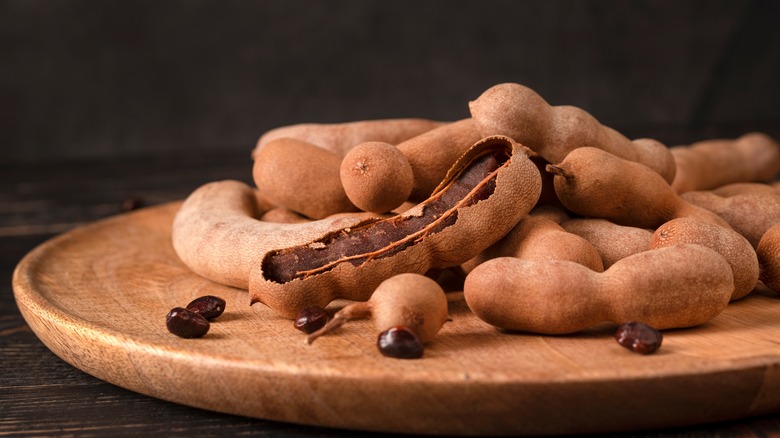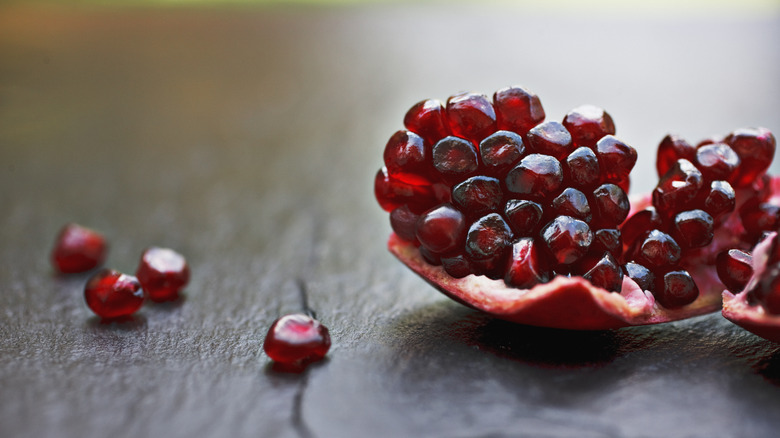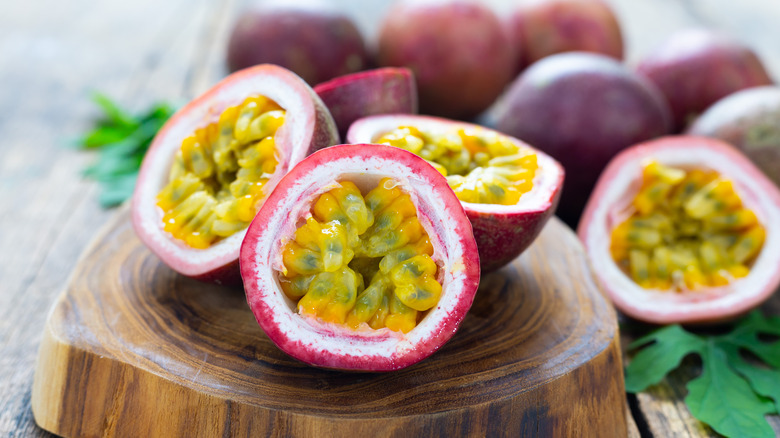19 Tropical Fruits, Ranked Worst To Best
We love our apples, our kiwis, and our peaches. But when it comes to fruit, it's hard to beat what the tropics have to offer. Tropical fruits are often sweeter and more intense in flavor than their temperate counterparts, making them a prime choice for fruit lovers everywhere who are lucky enough to get their hands on them. Tropical fruits generally taste better when they're consumed close to where they're grown, but even if you live far, far away from any place remotely tropical, there's a good chance you can still snag staples like bananas and avocados at your local grocery store.
Not all tropical fruits are created equally, though. Some are widespread favorites, appealing even to those who don't love fruit. Others, though, are more polarizing — not everyone can get down with durian, after all. We've taken a look at some of the world's most celebrated tropical fruits and ranked them, starting with the ones we don't care for and ending with those we could easily eat every day. Let's take a closer look at tropical fruits, ranked from worst to best.
19. Dragon fruit
From the outside, there are few fruits as appealing as dragon fruit. Its bright pink, spiky exterior looks simultaneously intimidating and inviting. Once you open it up, though, you're not met with more of that pink hue; rather, you'll see paper-white flesh dotted with tiny black seeds. It's a gorgeous fruit, but that's why it's often added to fruit salads — on the flavor front, it has very little to offer.
Take one bite of a dragon fruit, and you simply won't taste much. Some compare the flavor of dragon fruit to that of pear, but we think it's a little less intense than that. The texture isn't bad, and the crunch of the seeds adds a nice contrast. Does dragon fruit taste actively bad? No. But because of its lack of intensity, we have to put it in the very last place in our ranking.
18. Rambutan
Rambutan is another one of those fruits that looks utterly appealing but just doesn't really come through on flavor. The tiny pink fruits look almost hairy due to their delicate spikes. Once you get past the slightly intimidating interior, you're met with a translucent white flesh that has a lightly floral scent to it. Once you take a bite, you'll notice a pleasant, unassuming fruitiness that doesn't tastes somewhat like lychee.
We think rambutan can be fun to eat, but if we're looking for something with a really intense, concentrated flavor, we would be disappointed by what this fruit has to offer. If you're looking for something juicy and mild, rambutan is probably up your alley. If you want something with some more intensity, though, you're better off choosing a different fruit.
17. Durian
There are few fruits more polarizing than durian. Some claim it tastes nutty or cheesy, while others say it tastes like dirty socks. If you ask us, it's a little bit of both, and that's what makes it so interesting. Whether you enjoy durian or not has a lot to do with the individual fruit you get your hands on. Some of them lean more toward the fruitier end of the spectrum, while others have a bit more funk. However, we prefer a bit more reliability in our fruits. Opening a durian, a huge fruit that contains a lot of flesh, and smelling a whiff of that signature, almost garlicky scent, can be a turn-off for some.
It's safe to say that some people love durian and others hate it. We fall in the middle, but we probably wouldn't go out of our way to source it for a fruit salad.
16. Avocado
This may be a hot take, but we just don't think avocados are that interesting. Sure, they have a lovely creaminess that makes them appealing for texturally inclined fruit eaters, but other than that, avocados are pretty bland. Their slight, green flavor is infinitely more appealing when it's covered in spices and other ingredients. After all, when was the last time you ate avocado toast that had nothing on it, not even salt and pepper, except for the avocado? Probably never. There's just nothing going on that makes us want to go back for another bite.
If you're looking for a creamy alternative to butter, avocado has you covered. But if you want a delicious fruit experience, you're better off choosing pretty much any other fruit on this list.
15. Banana
Bananas are the most popular fruit in the world, but does that mean they deserve a top spot on our ranking? We don't think so. Bananas have an iconic, exceptionally strong flavor — so strong, in fact, that you can smell them on anything they touch. If you add bananas to your dessert, you're basically just eating a banana. And while we do enjoy the flavor of bananas, it can be too much sometimes — you have to be in the right mood to enjoy it.
Bananas are great for vegan baking and perfect for a quick, nutritious snack on the go. Plus, they're more affordable than most other fruits out there. There's a reason why they're so popular and so ubiquitous in grocery stores around the world. But are they the most delicious fruit of all time? Unfortunately not.
14. Lychee
Lychee looks a bit like rambutan, but its spikes are not quite so frilly. Once you peel off the rough pink skin, you're left with a white, translucent flesh that surrounds a hard pit. Lychee can be a bit tricky to eat if you're not used to it — you have to kind of suck the meat of the fruit off of the pit if you want to enjoy its juiciness to the fullest.
The flavor is also similar to rambutan, but it has more of a floral note than its fruity pink cousin. Some say they also taste notes of citrus, like orange and lemon, when they bite into the flesh of a lychee. They're definitely not the most flavorful fruit we've ever tried, but they are pleasant.
13. Papaya
If you like melon, there's a good chance you're going to enjoy papaya as well. It has a similar mild, floral quality to what you'd get in a melon, but it has a sweetness to it that you won't experience with, say, a honeydew. The texture is also significantly softer than that of a melon, which makes it easy to spoon out of its peel. Of course, you don't have to eat it that way — it's also delicious when it's cut up and added to fruit salads.
Did you know that you can also use the papaya seeds as well? When they're ground up, they have a slightly spicy flavor to them that's perfect for seasoning savory dishes. But while we enjoy papaya, it just doesn't pack enough flavor for it to end up any higher on our list. That shouldn't stop you from enjoying its juicy, orangey-pink flesh, though.
12. Pineapple
Pineapple is one of those fruits that's kind of hit or miss. If you get a good, fresh pineapple, you've hit the jackpot: The acidity complements the intense sweetness well, and you're left with a surprisingly balanced sweet treat. It's delicious on its own, of course, but pineapple can also be useful in a wide variety of culinary situations. For example, you can use pineapple (both the fruit and the juice) to marinate chicken breasts to make them extra juicy and succulent. You can also add pineapple to your drinks (alcoholic or not) to give them a burst of concentrated flavor.
However, if you happen to snag a bad pineapple, it can be a huge disappointment. When pineapples get too sweet, the flavor is downright cloying. Although it's possible to get a solid pineapple at your local grocery store in North America, they tend to taste better when you eat them closer to where they grow.
11. Mangosteen
If you live in the U.S., there's a chance that you've never encountered mangosteen before. That's because, at one time, mangosteen imports were banned in the U.S. over concerns that it would carry the Asian fruit fly. Officials ended the ban in 2007, but mangosteen is still irradiated before it enters the country.
If you've ever had it before, you know it tastes vaguely tropical — many who try it say it tastes similar to lychee, pineapple, and even strawberry. Some even claim that it has a floral quality. We love the unique combo of flavors mangosteen offers, and it's delicious on its own, but it's probably not a fruit we would put on our list grocery list if we were making a fruit salad.
10. Honeydew
You may be used to getting chunks of honeydew melon in those sad, soggy pre-cut fruit salads you snag at the refrigerated section of the grocery store, where they're often relegated to the very bottom of the plastic container. By the time you get to them, they've already been soaking in the juices of other fruits for a good 24 hours. But when you eat a freshly cut honeydew on its own, you're in for a serious treat. The flavor isn't that strong, but that's what we like about it. It's mild and refreshing, and it's exactly what you want to cut into when the weather outside is sweltering.
Want to take your honeydew to the next level? We think it's even better when it's sprinkled with some fresh lemon or lime juice. You can also add a spicy-salty seasoning, like Tajin, if you want to up the flavor factor.
9. Guava
Guava is one of the most beautiful fruits in the world. From the outside, the little green fruit looks relatively unassuming, so you wouldn't guess how gorgeous and brightly colored it is inside. But once you cut one open, you'll be met with a vibrant light pink color and a pleasant, fruity scent. Take a bite, and you might notice a pear-like consistency. However, the flavor is almost berry-like — we think it's somewhat similar to a strawberry.
Guava is delicious on its own, and it doesn't really need any extra ingredients to make it an enjoyable snack. But if you get the chance to enjoy it with cheese, perhaps in a pastry, you should jump at the opportunity. The sweet and acidic fruit goes perfectly with rich, creamy cheese.
8. Soursop
Soursop looks like what you would imagine a mango would look like if it suddenly grew spikes and never changed from green to that pretty orangey-red color. The spiky green fruit isn't as pretty as some of its tropical fruit counterparts, but it makes up for its lack of color with a complex flavor that'll keep you going back for more. As you can probably imagine from the name of the fruit, it has a sourness to it that you'll notice when you first take a bite. Keep chewing, though, and the sweetness will hit you as well. There's really no comparing it to any other fruit out there, but to us, the flavor is most similar to pineapple.
We think soursop is absolutely delicious, and although it's not one of our absolute favorite tropical fruits out there, we'd never turn it down.
7. Jackfruit
If you're buying jackfruit at a grocery store in most of North America, chances are you're not going to find the entire fruit unless you go to a specialty store. Rather, you're more likely to encounter packaged jackfruit in the vegetarian section. That's because the texture of jackfruit is often compared to pulled pork, and if you season the fibrous fruit like pork, then you get a lovely meat alternative that's perfect for adding to sandwiches, tacos, and more.
On its own, jackfruit is slightly sweet, but the flavor isn't going to blow you away. It's rather mild. The texture, though, is almost similar to pineapple in the way it pulls away in shreds. Whether you enjoy eating it on its own or you decide to treat it more like a meat alternative, jackfruit is definitely a fruit you have to try at least once in your life.
6. Acai
Smoothie bowl lovers, your time has come. We couldn't do a ranking of tropical fruits without including the cult-favorite acai. When you think of berries, you probably think of the tart, slightly sweet flavor profile you associate with strawberries or blackberries. But unlike most other berries, acai has a very specific flavor: It has an earthiness to it that some compare to chocolate. Of course, that fruitiness still shines through, but its richer undertones make for an interesting berry-eating experience.
In North America, when most people enjoy acai, they're eating the berries in their frozen form, often in a smoothie. This is because the berries spoil very quickly, making the fresh berries difficult to transport. Of course, the frozen stuff is still delicious, but if you want to get a taste of fresh acai, you'll have to make the trek to a tropical location where the plant grows.
5. Chayote
Many people think that chayote is a vegetable due to how it's often prepared. Technically, though, it is a fruit. If you've had it on its own, you may be wondering why it's earned a top spot in our ranking. Admittedly, it's kind of bland — there's not much going on in the flavor department, and its crisp texture isn't too far off from a cucumber. So what's to love?
We think chayote is special because of how versatile it is, precisely due to that lack of concentrated flavor. Some people roast or pan-fry their chayote, adding salt and seasonings to really make it shine. Others use their creativity to transform chayote into a kind of vegetarian ceviche. Sure, it may not be the fruit you'd pick to eat on its own for breakfast, but once you experience a top-notch chayote dish, you'll understand why it's one of our favorites.
4. Mango
How could mango not make it into our top four? Mango is a widely beloved fruit for good reason. Although it does have a distinct sweetness to it, that sweetness is balanced nicely with plenty of acidity. Pair that with the almost floral scent, and it's no wonder you'll find mango in just about any tropical fruit bowl.
You can eat mango in a variety of ways, and many people like it plain on its own. You're certainly not going to be disappointed with plain fresh mango, but if you want to take things a step further, you may want to add some other ingredients to the mix. For example, if you want to add some spice and salt to the equation, sprinkle some Tajin on top of your mango. And if you really want to draw out that acidity even more, consider pickling your mango. Add it to your next poke bowl and prepare for your fruit-eating life to change forever.
3. Tamarind
From the outside, tamarind doesn't look like anything special. It's just a brownish-looking pod that you probably wouldn't look twice at if you didn't know what kind of deliciousness awaited you inside. But once you break into the pulp and take a bite, you'll understand why tamarind is so widely beloved — and why it's such a popular fruit right now.
The pulp has a thick, almost paste-like texture and a distinctly sour flavor profile. If you're looking for an ultra-sweet tropical fruit, tamarind is not it. It's sweeter when it's ripe, but if you get it unripe, sour lovers will rejoice. You can chill your tamarind in the fridge, and once you take a bite, it'll taste like you're eating a piece of sour candy.
2. Pomegranate
If you're looking for the easiest fruit to eat, then you should probably pass up on the pomegranate. The pinkish-reddish fruit is known for its delicious seeds, which are wrapped in juicy pockets that burst open as you chew them. However, those seeds can be tricky to remove from the pomegranate, especially if you don't have much practice opening them.
But luckily, the deliciousness of a fruit is not measured by how easy it is to get at what's inside. And once you do manage to properly open your pomegranate, you're going to be blown away by just how delicious it can be. You've got some crunch from the seeds, of course, but that sweet, slightly tart juice is what we're really after. It can be fun to pick them from the fruit one by one, but we love harvesting all the seeds at once and eating them with a spoon from a bowl.
1. Passion fruit
Passion fruit is undeniably the most delicious fruit to ever appear in any fruit basket ever. The exterior of the fruit is pink and a bit tough. When you cut into the center of it, though, you're treated to the yellow-gold and black gems of the seeds and the pulp, and that's where the magic really lies. The ripe pulp is super sour, which is why we love this fruit so much. Yes, there's a touch of sweetness there, but you're mostly getting bright, lovely, and vibrant acidity in every bite.
But it's not just the taste we love — passion fruit is also special because of its texture. The seeds, if you eat them, offer just the right amount of crunch, which adds a whole new sensory experience to every bite. Passion fruit is delicious on its own, but we love it even more when it's incorporated into a dessert or spooned onto a smoothie bowl.
